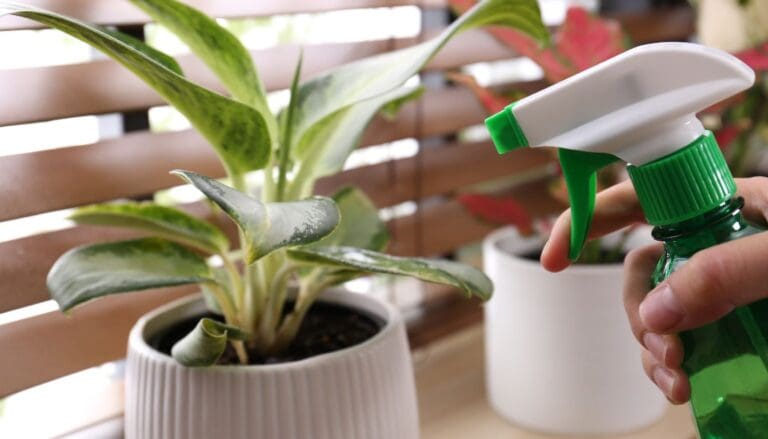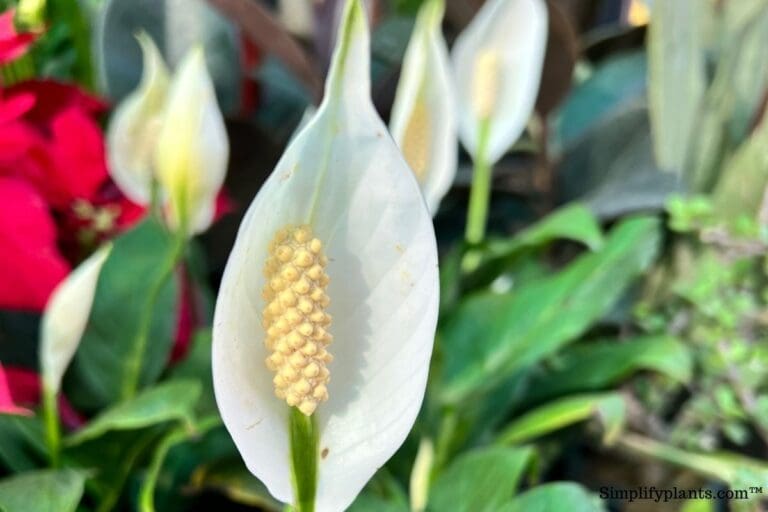Where Should I Place My Boston Fern? (Ideal Location+Tips)
Boston ferns are native to tropical regions and are popular because of their evergreen foliage and hardy nature. If you want to introduce this Boston fern in your home, you must know the correct spot to place it.
Boston ferns need to be kept in well-lit bright areas with indirect sunlight, proper warmth, and high humidity. Keep them away from hot and cold drafts and make sure the soil remains moist. While keeping them indoors, adding a humidifier helps in maintaining healthy foliage.
Though extremely hardy, if you place this plant in a spot where its needs are not met, the plant’s growth will get affected.
This article discusses the factors you should remember while choosing a spot for your Boston fern and some spots in the house that might or might not be right for the plant.

Please note: Simplify Plants is reader-supported. Some links in the post are affiliate links and I get a commission from purchases made through links in the post.
Factors determining the placement of Boston fern
It is crucial to understand the requirements of the Boston fern before placing it at a spot so that its health and growth are not hampered.
Let us understand the factors essential to the placement of your Boston fern.
Light
Ferns grow in the forest ground and are used to being in the shade in their native lands.
Boston ferns’ light requirements vary depending on the weather.
It prefers bright, indirect light in the fall and winter seasons.
Find a spot where it will get at least 2 hours of indirect sunlight during the morning or late afternoon.
Boston fern’s light requirements change when sunlight is more intense in spring and summer.
During these warmer times of the year, the Boston ferns require a semi-shaded location, such as a North-facing window.
Avoid exposing it to the direct sunlight from the south or west-facing window or balcony unless a sheer curtain protects the spot or if there is a tall tree standing as a barrier between the sunlight and the Boston fern.
Rotate your ferns every week to expose all sides to light and encourage even growth.
Consider two important factors while choosing the right spot of light for the plant.
- First, avoid scorching intense direct sunlight, which can quickly burn the delicate leaves of the Boston Fern
- Secondly, the plant will not thrive without sufficient light and is likely to drop leaves.
Also read: What Kind Of Lighting Does A Boston Fern Need?
Temperature
Although Boston ferns can grow outdoors year-round in the US hardiness zones 10 through 12, they are sensitive to certain amounts of cold and heat.
As tropical plants, Boston ferns thrive in warm, humid conditions.
You can grow them outdoors during summer almost anywhere, but they survive only in the warmer climates once fall arrives.
In most areas of the US, Boston ferns are grown as houseplants.
Boston ferns die if exposed to lower temperatures between 30-35°F.
The best indoor temperature range for this voluptuous plant is between 60-75°F.
If you do not know the temperature, you can get a thermometer or a hygrometer to measure the temperatures around the plant.
Temperatures above 95°F may kill a Boston fern.
Because wild Boston ferns grow on the forest floor shaded from sunlight, they don’t get exposed to high temperatures of direct sunlight.
And because they are tropical plants, they cannot tolerate low temperatures.
- While most yards do not have dense trees that Boston ferns prefer, a covered porch provides the correct light.
- If no porch is available, place it at a spot where it protects from direct harsh light.
Rapid and frequent fluctuation in temperature may kill the Boston fern.
Deformed foliage and fronds can occur due to extreme fluctuations in temperature.
They are sensitive to chill and are not adapted to sudden drops in temperatures.
- Avoid placing your Boston fern too close to radiators, cold draft, fireplace, and air conditioner vents.
- Avoid keeping them near windows and doors that are opened and closed too frequently as that can cause temperature fluctuations.
Humidity
High humidity is crucial, and one of the most important factors for tropical plants like Boston ferns is that they cannot thrive without high humidity.
Since, in the wild, they are used to high humidity levels, it is important to create that same environment for your Boston ferns if you grow them in your home.
Boston ferns love moisture and humidity and cannot tolerate low humidity and dry air, and will show clear signs of stress.
Some of the signs of low humidity on Boston ferns are:
- The premature dropping of leaves
- The tip of the fern becomes brown and crisp
- Dry, crispy leaves due to excessive drying of the plant
- The leaves start turning yellow as a sign of low humidity
Boston ferns require high humidity of around 80%.
Anything below 50% can damage the health of your plants, and you have to resort to artificial means to increase humidity around the Boston fern.
There are several ways to provide humidity to your plant. Let us discuss some of the means to raise the humidity of your homes:
- Pebble tray: This is a common and simple technique to increase humidity. For this, a tray or saucer is filled with a layer of pebbles. Now pour water on the pebbles and place the Boston fern pot on that pebbles layer. Ensure that the water does not touch the bottom of the pot. As this water evaporates, the humidity around the plant will also increase.
- Humidifier: Among all the ways to increase humidity around the plant, a humidifier is the best and provides a long-lasting result. You have to fill the humidifier with distilled water or rainwater and place it near the Boston fern or any moisture-loving plant. A humidifier lets you control the humidity level around your Boston fern, and you can increase or decrease the range as per your requirement.
- Misting: This is one of the most common methods to increase humidity around the plant. However, unfortunately, this is a temporary solution because the effects are not long-lasting, and the water evaporates very quickly. However, the frequency of misting depends on o the temperature and weather you live in. On a hot summer day, you may have to mist your plant daily or even multiple times every day. However, in cooler regions, you may not find the need to mist your fern, or misting every 2-3 days can be enough for your plant.
- Grouping the plants: You can put all the moisture-loving plants in a group. This lets them give off humidity to one another through transpiration and create a vapor transaction for each other.
Also read: Should I Mist My Boston Fern? (How Often+Pros & Cons)
Things to remember while placing a Boston fern
Let us look into some of the spots where you can keep your Boston fern.
Near a window

Boston ferns can be kept near a North-facing window during the hot summer months when the heat is intense.
This way, the fern will not get too much heat.
However, when the sunlight is less intense during the cold months, you can shift the Boston fern near a south or west-facing window to give it some bright light and warmth.
However, you mustn’t let the direct sunlight hit your Boston fern in any way.
You can put up a sheer curtain to create a barrier between the sunlight and the fern.
Keep the fern 5-10 feet away from the south-facing window during the fall or winter months.
Non-Toxic for children and pets

Here is good news for all houseplant lovers who hesitate to keep plants for fear of accidents to their children and pets.
According to the ASPCA, Boston fern is a safe and non-toxic indoor plant to keep around your children and pets.
Your kitty or puppy can play with your ferns and even bite on them.
However, it is recommended that to maintain the health and aesthetic appeal of your Boston fern, so you should keep it away from the reach of children or pets.
Avoid placing it near a fireplace
We already discussed that Boston ferns are sensitive to extreme cold or hot weather.
You should not keep the Boston fern near a fireplace.
Some plant owners like to keep their plants around the fireplace in winter to protect them from the cold and give them some warmth.
However, keeping it too close can affect your plant’s health as that will lead to heating of the plant and temperature fluctuations.
You can keep the Boston fern away by a safe distance to not directly feel the hot temperature of the fire while keeping it warm in the harsh cold.
It can enjoy some indirect heat, but the leaves will show signs of stress if it gets too hot.
The temperature of the room
The ideal temperature for your Boston ferns is 60-75°F.
The room where you keep your Boston fern should have this temperature range to thrive.
If the temperature is higher, your Boston fern will dry out more frequently and need more water and humidity to survive.
If the room gets extremely freezing in water, you need to care for the plant.
Since Boston ferns are tropical plants, they cannot tolerate harsh colds or frost.
Ensure the room is well insulated and not take the plant outside in this cold.
You have to give it as much warmth as you can.
If the room is comfortable for you, it should be comfortable for your plant.
Boston fern in your bedroom

Boston ferns are excellent air purifiers that help remove toxins from the air.
It filters out formaldehyde from the air and thus is a great plant for the bedrooms.
Aside from air-purifying, Boston ferns, with their gorgeous arching fronds, add so much elegance to your bedroom, especially if you grow them in a hanging basket where your children and pets cannot disturb them.
However, remember a few things before you add it to a bedroom.
- Keep the Boston fern in a spot that gets bright light but not the direct sun rays. There should be a filter between the sun’s rays and the plant.
- Keep rotating the plant every week so that every side of the plant gets light and grows evenly.
- Keep the Boston fern away from areas of temperature fluctuations like AC vents, heaters, and window panes, which affect the plant’s health.
- Do not forget these are moisture-loving plants, and you have to keep their humidity level or else the plant will suffer.
Boston fern in your bathroom
Boston ferns hail from the tropical and sub-tropical rainforest, making it an ideal plant for humid bathrooms.
Bathrooms have a higher range of humidity, which is ideal for your boson ferns.
Also, your Boston fern will detox the bathroom air for your benefit because of their air-purifying quality.
However, you must ensure that the bathroom has ample light and aeration.
If it does, you can move your Boston ferns there.
However, if your bathroom does not have much light and air circulation, you should not shift your plant there because Boston plants do not survive in low light.
Your Boston fern needs good airflow around it to keep away pests and bugs too.
So in the absence of them, do not keep the plant in the bathroom.
Do’s and don’t’s for the placement of Boston fern
We can finally conclude about the dos and don’ts for your Boston Ferns’ placement.
The below table has everything.
| Dos | Don’ts |
|---|---|
| Place your Boston fern near a window with indirect light. | Do not place the Boston fern in direct sunlight. You can use sheer curtains or a filter to protect it. |
| You can keep it in your bedroom. However, the conditions should be suitable for its growth. | Do not place it at a spot that gets direct air from AC or heater. |
| Keep the plant in your bathroom if it has sufficient airflow and suitable lights. | Do not keep the plant in your bathroom if it does not get proper light and air. Boston ferns cannot survive in extreme low lights. |
| If you wish to keep the Boston ferns outdoors, make sure the spot does not get direct sunlight and has a shade like a porch or big tree to protect it. | Do not keep your Boston fern outside unsheltered, and bring it inside to protect it from frost. |
| Your Boston fern requires high humidity to thrive. Use a humidifier and other techniques to increase humidity. | Do not keep the plant in a spot of low humidity because it cannot thrive. |
| Rotate your Boston fern so that all sides get even light. | Do not keep the Boston fern near frosty windows or cold drafts. |
Final words
From the discussion, it is clear which spots in your home are suitable for your Boston fern.
You can keep this gorgeous plant at any spot in your home as long as it gets all its requirements. You want a healthy Boston fern that makes your interior come alive at the end of the day.
If you notice any issue, check if the plant is getting everything it needs. If not, move it to a better spot.
Reference: University of Florida, The University of Arkansas Division, Texas A&M University System, The University of Georgia, University of New Hampshire, Wikipedia, The Royal Horticultural Society.
Recommended Garden Supplies
| Product Image | Our Recommended Gardening Supplies | Check Offers! |
|---|---|---|
Top Top
Top
Top
Top
Top
Top
Top
Top | rePotme Houseplant and Tropical Classic Potting Soil Mix | Check Offer On Amazon |
 Top
Top
Top
Top
Top
Top
Top
Top | Espoma Organic Indoor Plant Food | Check Offer On Amazon |
 Top
Top
Top
Top
Top
Top
Top
Top | GooingTop LED Grow Light 6000K Full Spectrum Clip Plant Growing Lamp | Check Offer On Amazon |
 Top
Top
Top
Top
Top
Top
Top
Top | Soil Moisture Meter | Check Offer On Amazon |
 Top
Top
Top
Top
Top
Top
Top
Top | Govee Hygrometer Thermometer, Bluetooth Enabled! | Check Offer On Amazon |
 Top
Top | LEVOIT Humidifiers for Large Room(Best For Plants) | Check Offer On Amazon |
 Top
Top
Top
Top
Top
Top
Top
Top | Upgraded DIY Automatic Drip Irrigation Kit, 15 Potted Houseplants Support | Check Offer On Amazon |
 Top
Top
Top
Top
Top
Top
Top
Top | Stainless Steel Heavy Duty Gardening Tool Set | Check Offer On Amazon |
 Top
Top
Top
Top
Top
Top
Top
Top | Bonide Insecticidal Soap | Check Offer On Amazon |
 Top
Top
Top
Top
Top
Top
Top
Top | Bonide 32 oz Spray Neem Oil for Organic Gardening | Check Offer On Amazon |
 Top
Top
Top
Top
Top
Top
Top
Top | Garden Safe Fungicide | Check Offer On Amazon |






